HRM Role in Churchill Insurance
VerifiedAdded on 2020/02/05
|19
|6215
|129
Report
AI Summary
This report is a case study analyzing the role of Human Resource Management (HRM) within Churchill Insurance Company. It begins by differentiating between traditional personnel management and modern HRM, highlighting HRM's contribution to Churchill's objectives. The report then delves into the recruitment and selection process, comparing Churchill's approach with that of John Lewis Partnership. Employee motivation and retention strategies are examined through the lens of motivational theories, and the effectiveness of Churchill's reward systems is assessed. The report also explores performance monitoring methods and the legal and regulatory framework impacting employment cessation. Finally, it concludes by summarizing the key HRM practices within Churchill Insurance Company and their overall effectiveness.
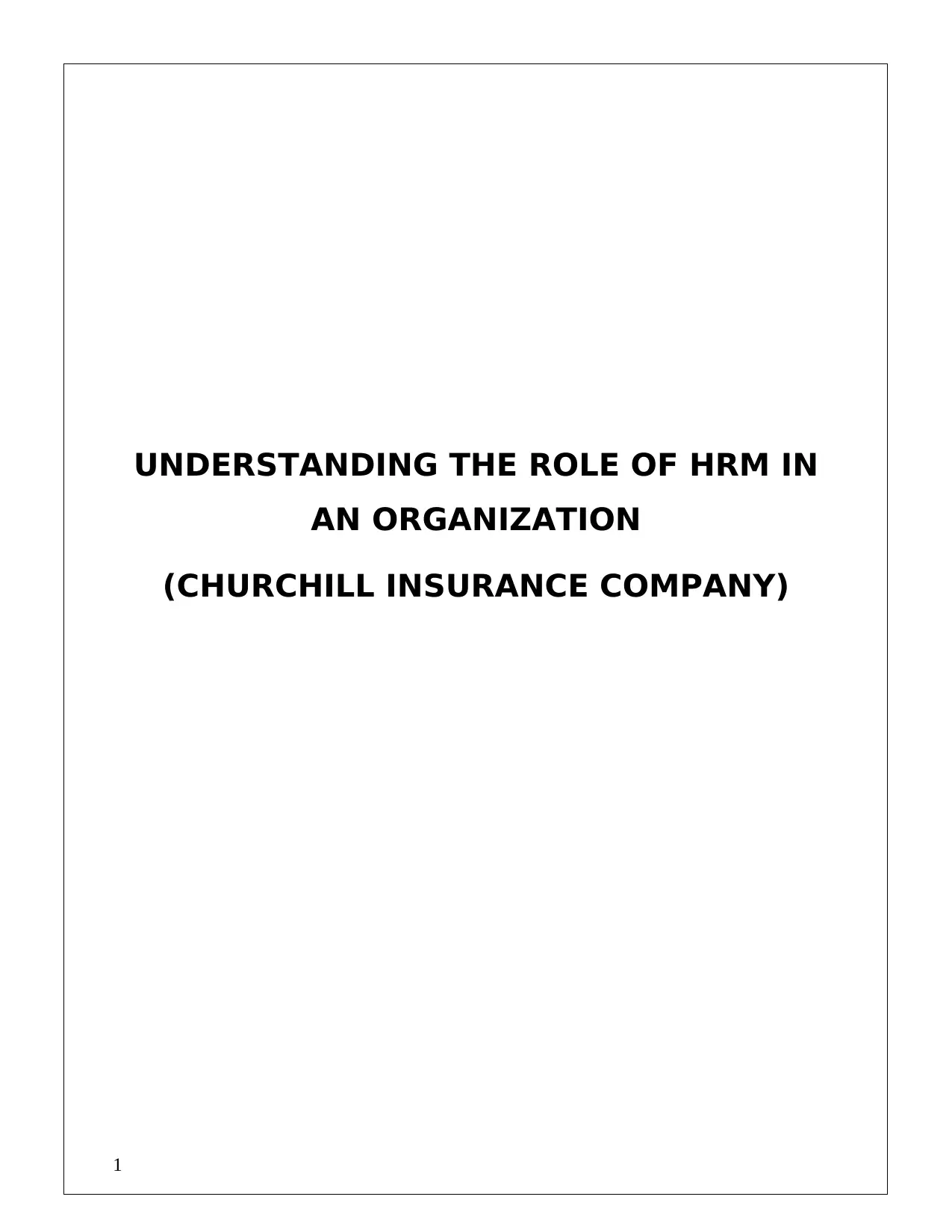
UNDERSTANDING THE ROLE OF HRM IN
AN ORGANIZATION
(CHURCHILL INSURANCE COMPANY)
1
AN ORGANIZATION
(CHURCHILL INSURANCE COMPANY)
1
Paraphrase This Document
Need a fresh take? Get an instant paraphrase of this document with our AI Paraphraser
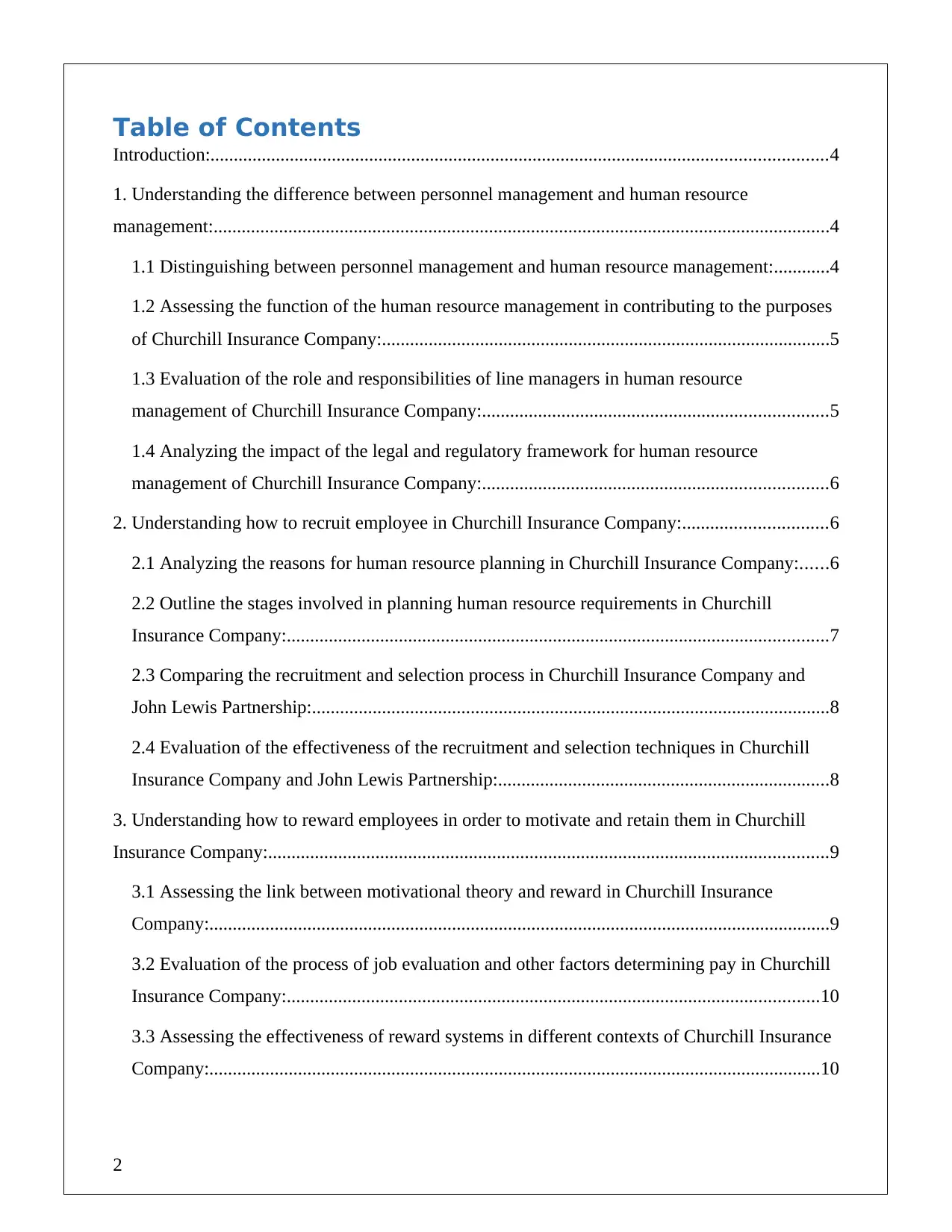
Table of Contents
Introduction:....................................................................................................................................4
1. Understanding the difference between personnel management and human resource
management:....................................................................................................................................4
1.1 Distinguishing between personnel management and human resource management:............4
1.2 Assessing the function of the human resource management in contributing to the purposes
of Churchill Insurance Company:................................................................................................5
1.3 Evaluation of the role and responsibilities of line managers in human resource
management of Churchill Insurance Company:..........................................................................5
1.4 Analyzing the impact of the legal and regulatory framework for human resource
management of Churchill Insurance Company:..........................................................................6
2. Understanding how to recruit employee in Churchill Insurance Company:...............................6
2.1 Analyzing the reasons for human resource planning in Churchill Insurance Company:......6
2.2 Outline the stages involved in planning human resource requirements in Churchill
Insurance Company:....................................................................................................................7
2.3 Comparing the recruitment and selection process in Churchill Insurance Company and
John Lewis Partnership:...............................................................................................................8
2.4 Evaluation of the effectiveness of the recruitment and selection techniques in Churchill
Insurance Company and John Lewis Partnership:.......................................................................8
3. Understanding how to reward employees in order to motivate and retain them in Churchill
Insurance Company:........................................................................................................................9
3.1 Assessing the link between motivational theory and reward in Churchill Insurance
Company:.....................................................................................................................................9
3.2 Evaluation of the process of job evaluation and other factors determining pay in Churchill
Insurance Company:..................................................................................................................10
3.3 Assessing the effectiveness of reward systems in different contexts of Churchill Insurance
Company:...................................................................................................................................10
2
Introduction:....................................................................................................................................4
1. Understanding the difference between personnel management and human resource
management:....................................................................................................................................4
1.1 Distinguishing between personnel management and human resource management:............4
1.2 Assessing the function of the human resource management in contributing to the purposes
of Churchill Insurance Company:................................................................................................5
1.3 Evaluation of the role and responsibilities of line managers in human resource
management of Churchill Insurance Company:..........................................................................5
1.4 Analyzing the impact of the legal and regulatory framework for human resource
management of Churchill Insurance Company:..........................................................................6
2. Understanding how to recruit employee in Churchill Insurance Company:...............................6
2.1 Analyzing the reasons for human resource planning in Churchill Insurance Company:......6
2.2 Outline the stages involved in planning human resource requirements in Churchill
Insurance Company:....................................................................................................................7
2.3 Comparing the recruitment and selection process in Churchill Insurance Company and
John Lewis Partnership:...............................................................................................................8
2.4 Evaluation of the effectiveness of the recruitment and selection techniques in Churchill
Insurance Company and John Lewis Partnership:.......................................................................8
3. Understanding how to reward employees in order to motivate and retain them in Churchill
Insurance Company:........................................................................................................................9
3.1 Assessing the link between motivational theory and reward in Churchill Insurance
Company:.....................................................................................................................................9
3.2 Evaluation of the process of job evaluation and other factors determining pay in Churchill
Insurance Company:..................................................................................................................10
3.3 Assessing the effectiveness of reward systems in different contexts of Churchill Insurance
Company:...................................................................................................................................10
2
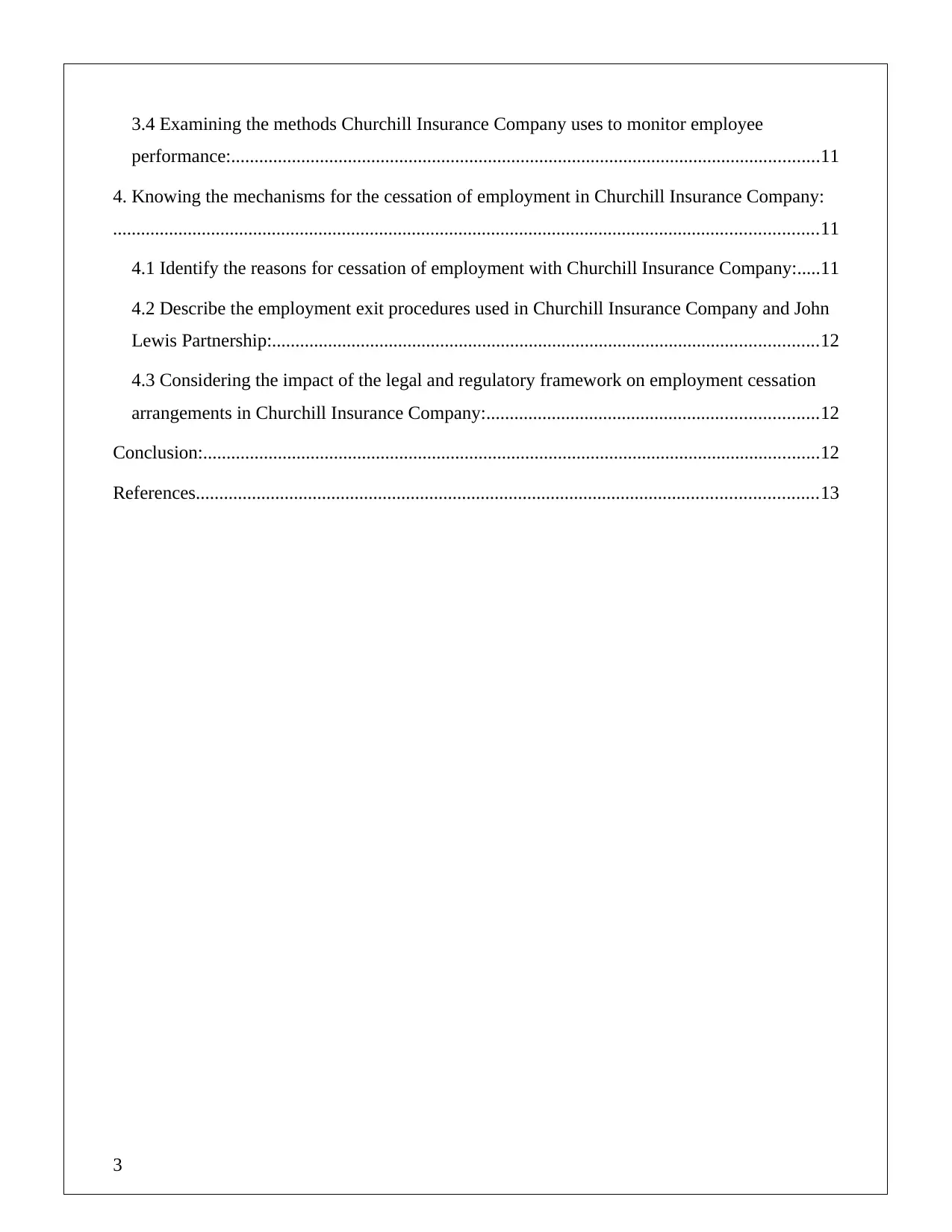
3.4 Examining the methods Churchill Insurance Company uses to monitor employee
performance:..............................................................................................................................11
4. Knowing the mechanisms for the cessation of employment in Churchill Insurance Company:
.......................................................................................................................................................11
4.1 Identify the reasons for cessation of employment with Churchill Insurance Company:.....11
4.2 Describe the employment exit procedures used in Churchill Insurance Company and John
Lewis Partnership:.....................................................................................................................12
4.3 Considering the impact of the legal and regulatory framework on employment cessation
arrangements in Churchill Insurance Company:.......................................................................12
Conclusion:....................................................................................................................................12
References.....................................................................................................................................13
3
performance:..............................................................................................................................11
4. Knowing the mechanisms for the cessation of employment in Churchill Insurance Company:
.......................................................................................................................................................11
4.1 Identify the reasons for cessation of employment with Churchill Insurance Company:.....11
4.2 Describe the employment exit procedures used in Churchill Insurance Company and John
Lewis Partnership:.....................................................................................................................12
4.3 Considering the impact of the legal and regulatory framework on employment cessation
arrangements in Churchill Insurance Company:.......................................................................12
Conclusion:....................................................................................................................................12
References.....................................................................................................................................13
3
⊘ This is a preview!⊘
Do you want full access?
Subscribe today to unlock all pages.

Trusted by 1+ million students worldwide
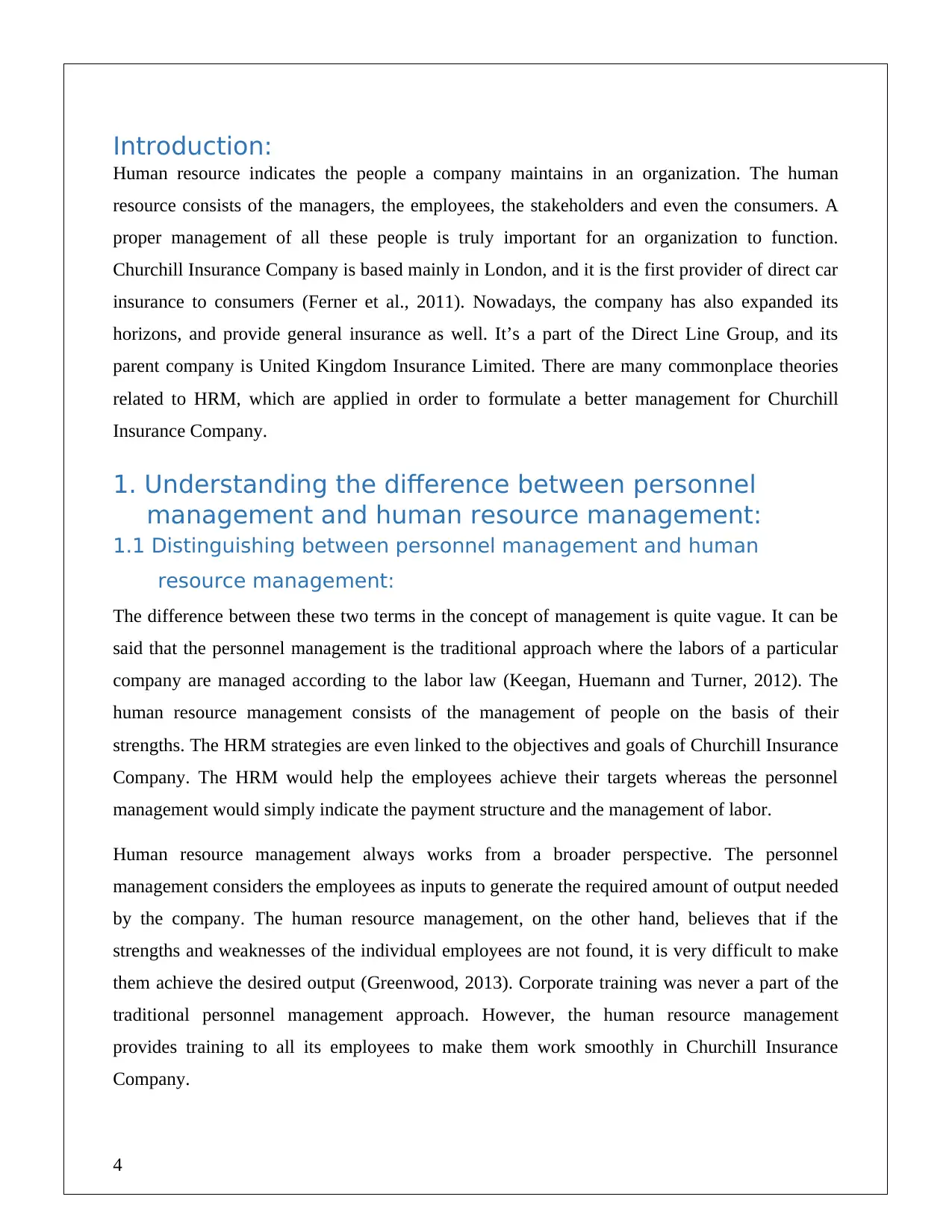
Introduction:
Human resource indicates the people a company maintains in an organization. The human
resource consists of the managers, the employees, the stakeholders and even the consumers. A
proper management of all these people is truly important for an organization to function.
Churchill Insurance Company is based mainly in London, and it is the first provider of direct car
insurance to consumers (Ferner et al., 2011). Nowadays, the company has also expanded its
horizons, and provide general insurance as well. It’s a part of the Direct Line Group, and its
parent company is United Kingdom Insurance Limited. There are many commonplace theories
related to HRM, which are applied in order to formulate a better management for Churchill
Insurance Company.
1. Understanding the difference between personnel
management and human resource management:
1.1 Distinguishing between personnel management and human
resource management:
The difference between these two terms in the concept of management is quite vague. It can be
said that the personnel management is the traditional approach where the labors of a particular
company are managed according to the labor law (Keegan, Huemann and Turner, 2012). The
human resource management consists of the management of people on the basis of their
strengths. The HRM strategies are even linked to the objectives and goals of Churchill Insurance
Company. The HRM would help the employees achieve their targets whereas the personnel
management would simply indicate the payment structure and the management of labor.
Human resource management always works from a broader perspective. The personnel
management considers the employees as inputs to generate the required amount of output needed
by the company. The human resource management, on the other hand, believes that if the
strengths and weaknesses of the individual employees are not found, it is very difficult to make
them achieve the desired output (Greenwood, 2013). Corporate training was never a part of the
traditional personnel management approach. However, the human resource management
provides training to all its employees to make them work smoothly in Churchill Insurance
Company.
4
Human resource indicates the people a company maintains in an organization. The human
resource consists of the managers, the employees, the stakeholders and even the consumers. A
proper management of all these people is truly important for an organization to function.
Churchill Insurance Company is based mainly in London, and it is the first provider of direct car
insurance to consumers (Ferner et al., 2011). Nowadays, the company has also expanded its
horizons, and provide general insurance as well. It’s a part of the Direct Line Group, and its
parent company is United Kingdom Insurance Limited. There are many commonplace theories
related to HRM, which are applied in order to formulate a better management for Churchill
Insurance Company.
1. Understanding the difference between personnel
management and human resource management:
1.1 Distinguishing between personnel management and human
resource management:
The difference between these two terms in the concept of management is quite vague. It can be
said that the personnel management is the traditional approach where the labors of a particular
company are managed according to the labor law (Keegan, Huemann and Turner, 2012). The
human resource management consists of the management of people on the basis of their
strengths. The HRM strategies are even linked to the objectives and goals of Churchill Insurance
Company. The HRM would help the employees achieve their targets whereas the personnel
management would simply indicate the payment structure and the management of labor.
Human resource management always works from a broader perspective. The personnel
management considers the employees as inputs to generate the required amount of output needed
by the company. The human resource management, on the other hand, believes that if the
strengths and weaknesses of the individual employees are not found, it is very difficult to make
them achieve the desired output (Greenwood, 2013). Corporate training was never a part of the
traditional personnel management approach. However, the human resource management
provides training to all its employees to make them work smoothly in Churchill Insurance
Company.
4
Paraphrase This Document
Need a fresh take? Get an instant paraphrase of this document with our AI Paraphraser
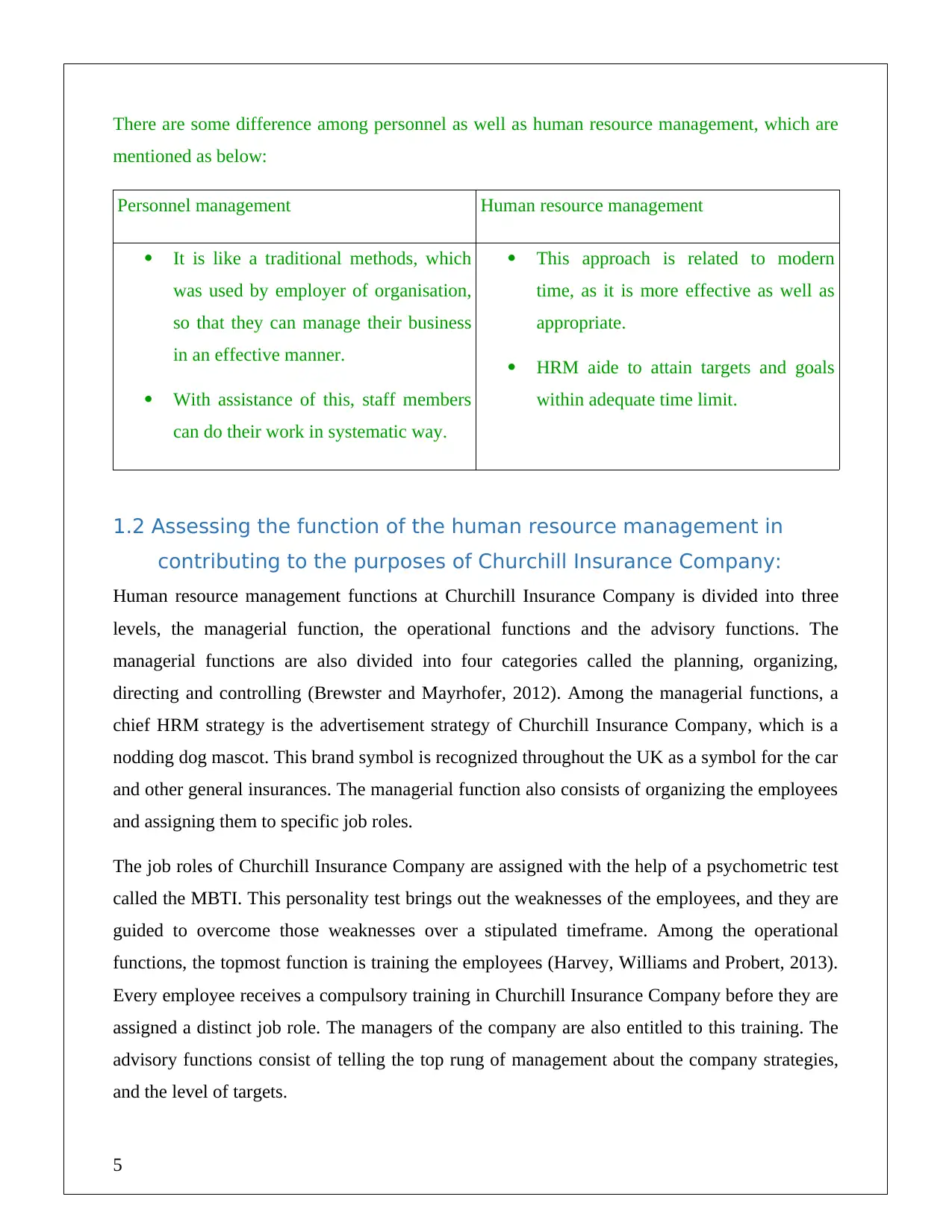
There are some difference among personnel as well as human resource management, which are
mentioned as below:
Personnel management Human resource management
It is like a traditional methods, which
was used by employer of organisation,
so that they can manage their business
in an effective manner.
With assistance of this, staff members
can do their work in systematic way.
This approach is related to modern
time, as it is more effective as well as
appropriate.
HRM aide to attain targets and goals
within adequate time limit.
1.2 Assessing the function of the human resource management in
contributing to the purposes of Churchill Insurance Company:
Human resource management functions at Churchill Insurance Company is divided into three
levels, the managerial function, the operational functions and the advisory functions. The
managerial functions are also divided into four categories called the planning, organizing,
directing and controlling (Brewster and Mayrhofer, 2012). Among the managerial functions, a
chief HRM strategy is the advertisement strategy of Churchill Insurance Company, which is a
nodding dog mascot. This brand symbol is recognized throughout the UK as a symbol for the car
and other general insurances. The managerial function also consists of organizing the employees
and assigning them to specific job roles.
The job roles of Churchill Insurance Company are assigned with the help of a psychometric test
called the MBTI. This personality test brings out the weaknesses of the employees, and they are
guided to overcome those weaknesses over a stipulated timeframe. Among the operational
functions, the topmost function is training the employees (Harvey, Williams and Probert, 2013).
Every employee receives a compulsory training in Churchill Insurance Company before they are
assigned a distinct job role. The managers of the company are also entitled to this training. The
advisory functions consist of telling the top rung of management about the company strategies,
and the level of targets.
5
mentioned as below:
Personnel management Human resource management
It is like a traditional methods, which
was used by employer of organisation,
so that they can manage their business
in an effective manner.
With assistance of this, staff members
can do their work in systematic way.
This approach is related to modern
time, as it is more effective as well as
appropriate.
HRM aide to attain targets and goals
within adequate time limit.
1.2 Assessing the function of the human resource management in
contributing to the purposes of Churchill Insurance Company:
Human resource management functions at Churchill Insurance Company is divided into three
levels, the managerial function, the operational functions and the advisory functions. The
managerial functions are also divided into four categories called the planning, organizing,
directing and controlling (Brewster and Mayrhofer, 2012). Among the managerial functions, a
chief HRM strategy is the advertisement strategy of Churchill Insurance Company, which is a
nodding dog mascot. This brand symbol is recognized throughout the UK as a symbol for the car
and other general insurances. The managerial function also consists of organizing the employees
and assigning them to specific job roles.
The job roles of Churchill Insurance Company are assigned with the help of a psychometric test
called the MBTI. This personality test brings out the weaknesses of the employees, and they are
guided to overcome those weaknesses over a stipulated timeframe. Among the operational
functions, the topmost function is training the employees (Harvey, Williams and Probert, 2013).
Every employee receives a compulsory training in Churchill Insurance Company before they are
assigned a distinct job role. The managers of the company are also entitled to this training. The
advisory functions consist of telling the top rung of management about the company strategies,
and the level of targets.
5
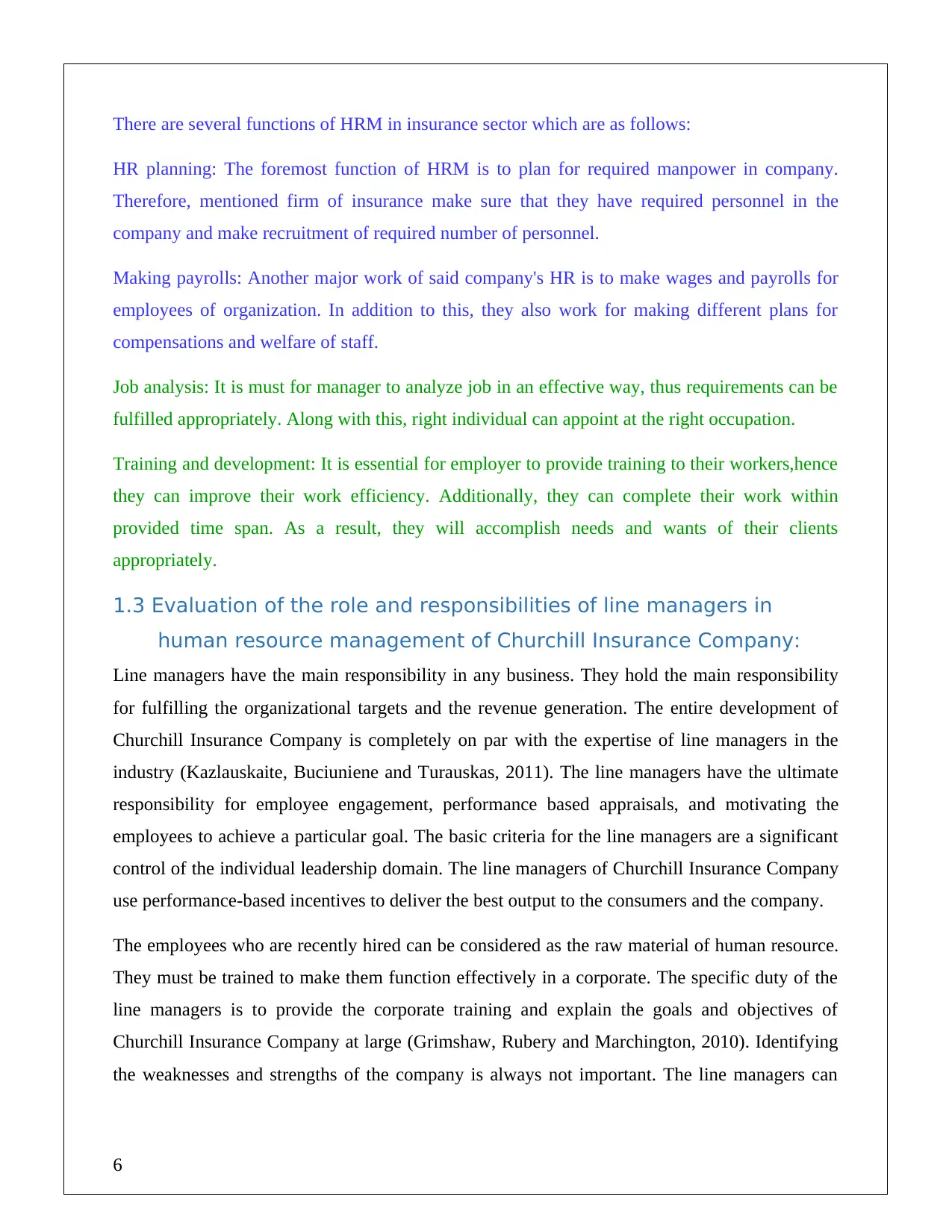
There are several functions of HRM in insurance sector which are as follows:
HR planning: The foremost function of HRM is to plan for required manpower in company.
Therefore, mentioned firm of insurance make sure that they have required personnel in the
company and make recruitment of required number of personnel.
Making payrolls: Another major work of said company's HR is to make wages and payrolls for
employees of organization. In addition to this, they also work for making different plans for
compensations and welfare of staff.
Job analysis: It is must for manager to analyze job in an effective way, thus requirements can be
fulfilled appropriately. Along with this, right individual can appoint at the right occupation.
Training and development: It is essential for employer to provide training to their workers,hence
they can improve their work efficiency. Additionally, they can complete their work within
provided time span. As a result, they will accomplish needs and wants of their clients
appropriately.
1.3 Evaluation of the role and responsibilities of line managers in
human resource management of Churchill Insurance Company:
Line managers have the main responsibility in any business. They hold the main responsibility
for fulfilling the organizational targets and the revenue generation. The entire development of
Churchill Insurance Company is completely on par with the expertise of line managers in the
industry (Kazlauskaite, Buciuniene and Turauskas, 2011). The line managers have the ultimate
responsibility for employee engagement, performance based appraisals, and motivating the
employees to achieve a particular goal. The basic criteria for the line managers are a significant
control of the individual leadership domain. The line managers of Churchill Insurance Company
use performance-based incentives to deliver the best output to the consumers and the company.
The employees who are recently hired can be considered as the raw material of human resource.
They must be trained to make them function effectively in a corporate. The specific duty of the
line managers is to provide the corporate training and explain the goals and objectives of
Churchill Insurance Company at large (Grimshaw, Rubery and Marchington, 2010). Identifying
the weaknesses and strengths of the company is always not important. The line managers can
6
HR planning: The foremost function of HRM is to plan for required manpower in company.
Therefore, mentioned firm of insurance make sure that they have required personnel in the
company and make recruitment of required number of personnel.
Making payrolls: Another major work of said company's HR is to make wages and payrolls for
employees of organization. In addition to this, they also work for making different plans for
compensations and welfare of staff.
Job analysis: It is must for manager to analyze job in an effective way, thus requirements can be
fulfilled appropriately. Along with this, right individual can appoint at the right occupation.
Training and development: It is essential for employer to provide training to their workers,hence
they can improve their work efficiency. Additionally, they can complete their work within
provided time span. As a result, they will accomplish needs and wants of their clients
appropriately.
1.3 Evaluation of the role and responsibilities of line managers in
human resource management of Churchill Insurance Company:
Line managers have the main responsibility in any business. They hold the main responsibility
for fulfilling the organizational targets and the revenue generation. The entire development of
Churchill Insurance Company is completely on par with the expertise of line managers in the
industry (Kazlauskaite, Buciuniene and Turauskas, 2011). The line managers have the ultimate
responsibility for employee engagement, performance based appraisals, and motivating the
employees to achieve a particular goal. The basic criteria for the line managers are a significant
control of the individual leadership domain. The line managers of Churchill Insurance Company
use performance-based incentives to deliver the best output to the consumers and the company.
The employees who are recently hired can be considered as the raw material of human resource.
They must be trained to make them function effectively in a corporate. The specific duty of the
line managers is to provide the corporate training and explain the goals and objectives of
Churchill Insurance Company at large (Grimshaw, Rubery and Marchington, 2010). Identifying
the weaknesses and strengths of the company is always not important. The line managers can
6
⊘ This is a preview!⊘
Do you want full access?
Subscribe today to unlock all pages.

Trusted by 1+ million students worldwide
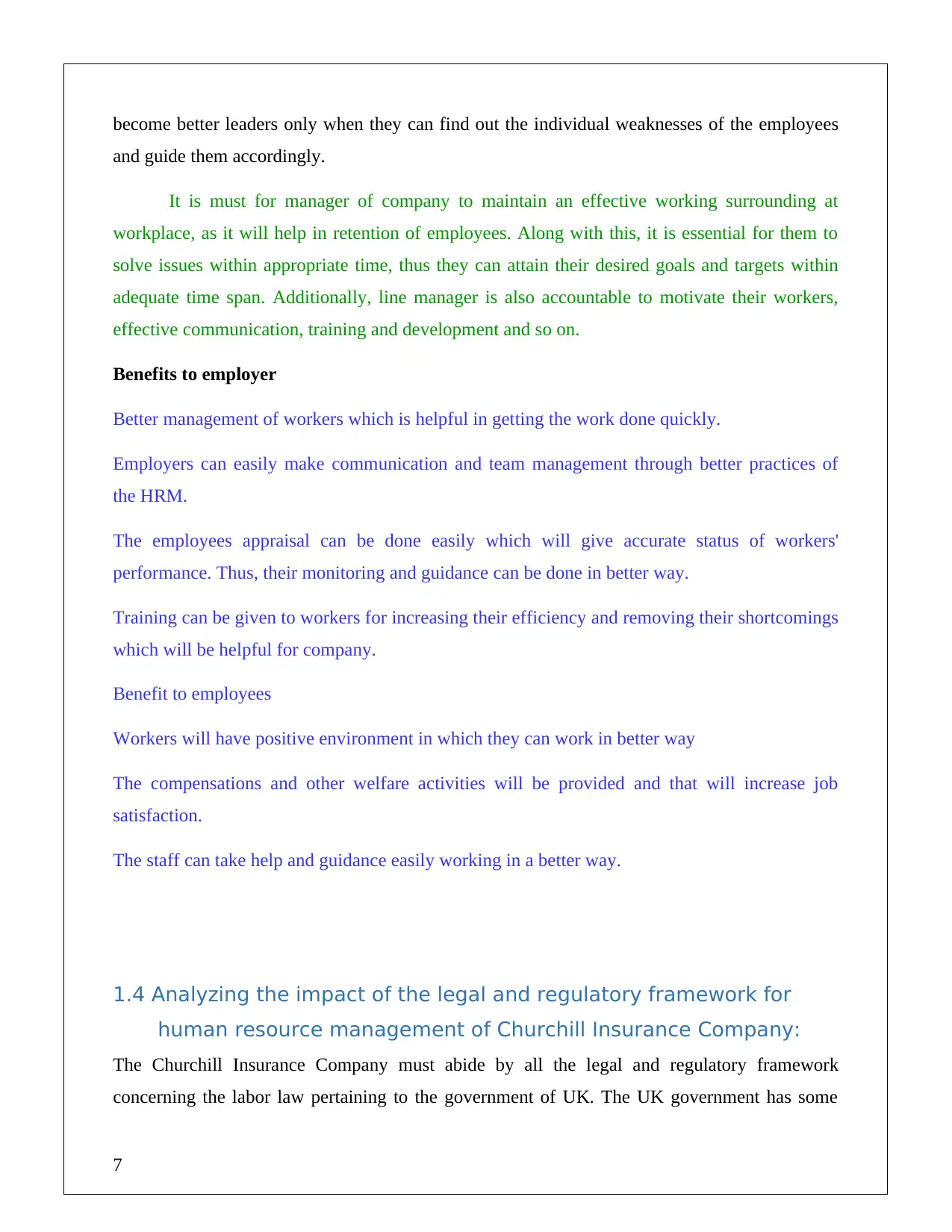
become better leaders only when they can find out the individual weaknesses of the employees
and guide them accordingly.
It is must for manager of company to maintain an effective working surrounding at
workplace, as it will help in retention of employees. Along with this, it is essential for them to
solve issues within appropriate time, thus they can attain their desired goals and targets within
adequate time span. Additionally, line manager is also accountable to motivate their workers,
effective communication, training and development and so on.
Benefits to employer
Better management of workers which is helpful in getting the work done quickly.
Employers can easily make communication and team management through better practices of
the HRM.
The employees appraisal can be done easily which will give accurate status of workers'
performance. Thus, their monitoring and guidance can be done in better way.
Training can be given to workers for increasing their efficiency and removing their shortcomings
which will be helpful for company.
Benefit to employees
Workers will have positive environment in which they can work in better way
The compensations and other welfare activities will be provided and that will increase job
satisfaction.
The staff can take help and guidance easily working in a better way.
1.4 Analyzing the impact of the legal and regulatory framework for
human resource management of Churchill Insurance Company:
The Churchill Insurance Company must abide by all the legal and regulatory framework
concerning the labor law pertaining to the government of UK. The UK government has some
7
and guide them accordingly.
It is must for manager of company to maintain an effective working surrounding at
workplace, as it will help in retention of employees. Along with this, it is essential for them to
solve issues within appropriate time, thus they can attain their desired goals and targets within
adequate time span. Additionally, line manager is also accountable to motivate their workers,
effective communication, training and development and so on.
Benefits to employer
Better management of workers which is helpful in getting the work done quickly.
Employers can easily make communication and team management through better practices of
the HRM.
The employees appraisal can be done easily which will give accurate status of workers'
performance. Thus, their monitoring and guidance can be done in better way.
Training can be given to workers for increasing their efficiency and removing their shortcomings
which will be helpful for company.
Benefit to employees
Workers will have positive environment in which they can work in better way
The compensations and other welfare activities will be provided and that will increase job
satisfaction.
The staff can take help and guidance easily working in a better way.
1.4 Analyzing the impact of the legal and regulatory framework for
human resource management of Churchill Insurance Company:
The Churchill Insurance Company must abide by all the legal and regulatory framework
concerning the labor law pertaining to the government of UK. The UK government has some
7
Paraphrase This Document
Need a fresh take? Get an instant paraphrase of this document with our AI Paraphraser
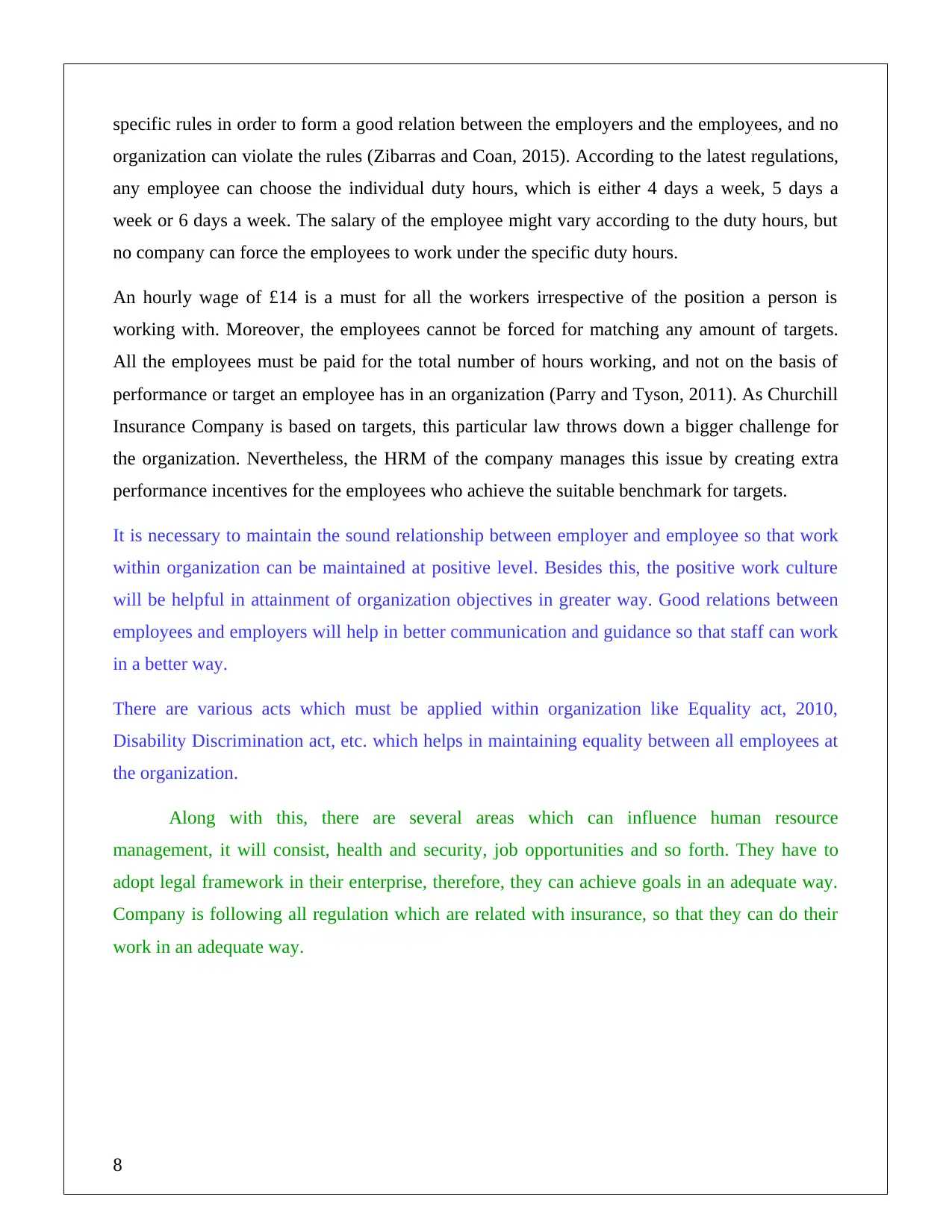
specific rules in order to form a good relation between the employers and the employees, and no
organization can violate the rules (Zibarras and Coan, 2015). According to the latest regulations,
any employee can choose the individual duty hours, which is either 4 days a week, 5 days a
week or 6 days a week. The salary of the employee might vary according to the duty hours, but
no company can force the employees to work under the specific duty hours.
An hourly wage of £14 is a must for all the workers irrespective of the position a person is
working with. Moreover, the employees cannot be forced for matching any amount of targets.
All the employees must be paid for the total number of hours working, and not on the basis of
performance or target an employee has in an organization (Parry and Tyson, 2011). As Churchill
Insurance Company is based on targets, this particular law throws down a bigger challenge for
the organization. Nevertheless, the HRM of the company manages this issue by creating extra
performance incentives for the employees who achieve the suitable benchmark for targets.
It is necessary to maintain the sound relationship between employer and employee so that work
within organization can be maintained at positive level. Besides this, the positive work culture
will be helpful in attainment of organization objectives in greater way. Good relations between
employees and employers will help in better communication and guidance so that staff can work
in a better way.
There are various acts which must be applied within organization like Equality act, 2010,
Disability Discrimination act, etc. which helps in maintaining equality between all employees at
the organization.
Along with this, there are several areas which can influence human resource
management, it will consist, health and security, job opportunities and so forth. They have to
adopt legal framework in their enterprise, therefore, they can achieve goals in an adequate way.
Company is following all regulation which are related with insurance, so that they can do their
work in an adequate way.
8
organization can violate the rules (Zibarras and Coan, 2015). According to the latest regulations,
any employee can choose the individual duty hours, which is either 4 days a week, 5 days a
week or 6 days a week. The salary of the employee might vary according to the duty hours, but
no company can force the employees to work under the specific duty hours.
An hourly wage of £14 is a must for all the workers irrespective of the position a person is
working with. Moreover, the employees cannot be forced for matching any amount of targets.
All the employees must be paid for the total number of hours working, and not on the basis of
performance or target an employee has in an organization (Parry and Tyson, 2011). As Churchill
Insurance Company is based on targets, this particular law throws down a bigger challenge for
the organization. Nevertheless, the HRM of the company manages this issue by creating extra
performance incentives for the employees who achieve the suitable benchmark for targets.
It is necessary to maintain the sound relationship between employer and employee so that work
within organization can be maintained at positive level. Besides this, the positive work culture
will be helpful in attainment of organization objectives in greater way. Good relations between
employees and employers will help in better communication and guidance so that staff can work
in a better way.
There are various acts which must be applied within organization like Equality act, 2010,
Disability Discrimination act, etc. which helps in maintaining equality between all employees at
the organization.
Along with this, there are several areas which can influence human resource
management, it will consist, health and security, job opportunities and so forth. They have to
adopt legal framework in their enterprise, therefore, they can achieve goals in an adequate way.
Company is following all regulation which are related with insurance, so that they can do their
work in an adequate way.
8
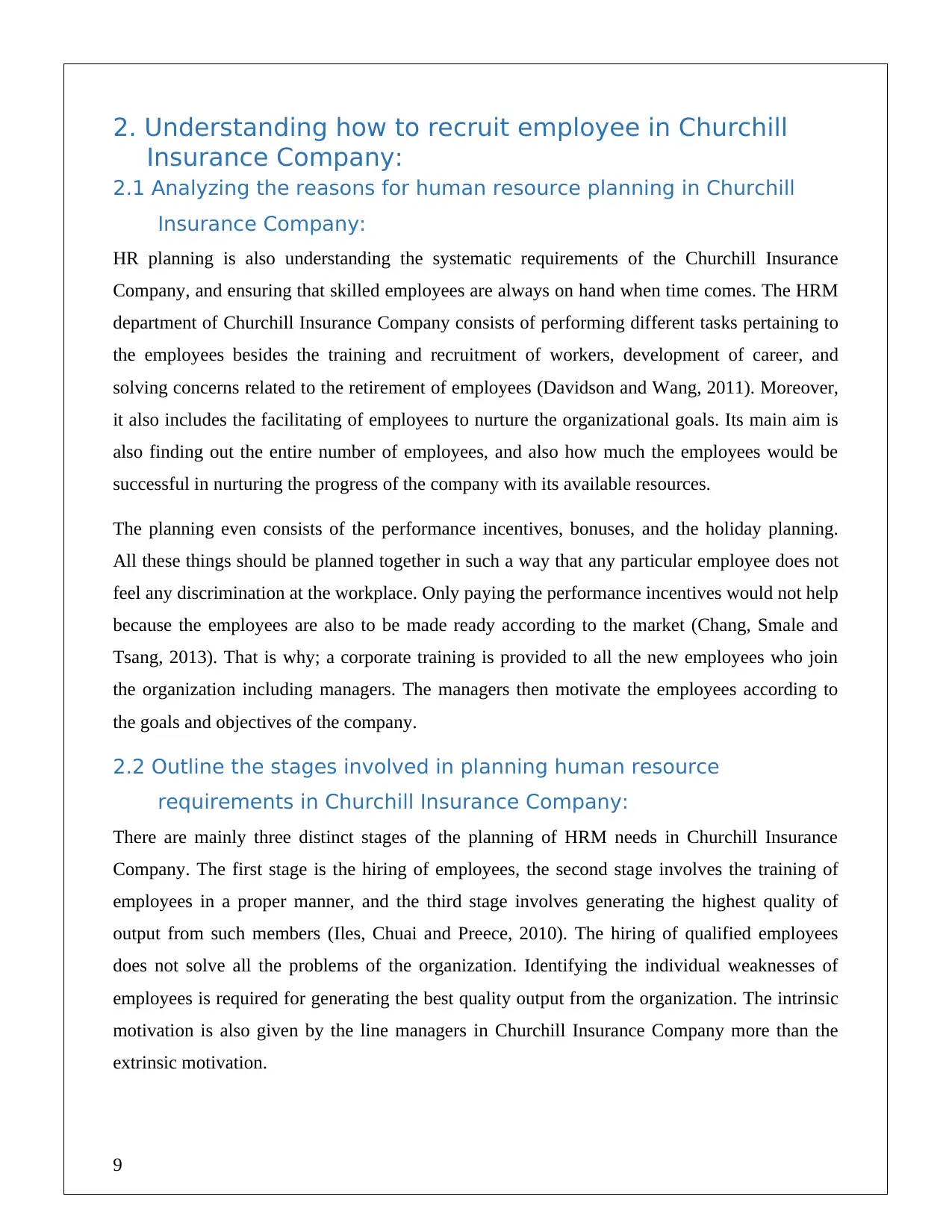
2. Understanding how to recruit employee in Churchill
Insurance Company:
2.1 Analyzing the reasons for human resource planning in Churchill
Insurance Company:
HR planning is also understanding the systematic requirements of the Churchill Insurance
Company, and ensuring that skilled employees are always on hand when time comes. The HRM
department of Churchill Insurance Company consists of performing different tasks pertaining to
the employees besides the training and recruitment of workers, development of career, and
solving concerns related to the retirement of employees (Davidson and Wang, 2011). Moreover,
it also includes the facilitating of employees to nurture the organizational goals. Its main aim is
also finding out the entire number of employees, and also how much the employees would be
successful in nurturing the progress of the company with its available resources.
The planning even consists of the performance incentives, bonuses, and the holiday planning.
All these things should be planned together in such a way that any particular employee does not
feel any discrimination at the workplace. Only paying the performance incentives would not help
because the employees are also to be made ready according to the market (Chang, Smale and
Tsang, 2013). That is why; a corporate training is provided to all the new employees who join
the organization including managers. The managers then motivate the employees according to
the goals and objectives of the company.
2.2 Outline the stages involved in planning human resource
requirements in Churchill Insurance Company:
There are mainly three distinct stages of the planning of HRM needs in Churchill Insurance
Company. The first stage is the hiring of employees, the second stage involves the training of
employees in a proper manner, and the third stage involves generating the highest quality of
output from such members (Iles, Chuai and Preece, 2010). The hiring of qualified employees
does not solve all the problems of the organization. Identifying the individual weaknesses of
employees is required for generating the best quality output from the organization. The intrinsic
motivation is also given by the line managers in Churchill Insurance Company more than the
extrinsic motivation.
9
Insurance Company:
2.1 Analyzing the reasons for human resource planning in Churchill
Insurance Company:
HR planning is also understanding the systematic requirements of the Churchill Insurance
Company, and ensuring that skilled employees are always on hand when time comes. The HRM
department of Churchill Insurance Company consists of performing different tasks pertaining to
the employees besides the training and recruitment of workers, development of career, and
solving concerns related to the retirement of employees (Davidson and Wang, 2011). Moreover,
it also includes the facilitating of employees to nurture the organizational goals. Its main aim is
also finding out the entire number of employees, and also how much the employees would be
successful in nurturing the progress of the company with its available resources.
The planning even consists of the performance incentives, bonuses, and the holiday planning.
All these things should be planned together in such a way that any particular employee does not
feel any discrimination at the workplace. Only paying the performance incentives would not help
because the employees are also to be made ready according to the market (Chang, Smale and
Tsang, 2013). That is why; a corporate training is provided to all the new employees who join
the organization including managers. The managers then motivate the employees according to
the goals and objectives of the company.
2.2 Outline the stages involved in planning human resource
requirements in Churchill Insurance Company:
There are mainly three distinct stages of the planning of HRM needs in Churchill Insurance
Company. The first stage is the hiring of employees, the second stage involves the training of
employees in a proper manner, and the third stage involves generating the highest quality of
output from such members (Iles, Chuai and Preece, 2010). The hiring of qualified employees
does not solve all the problems of the organization. Identifying the individual weaknesses of
employees is required for generating the best quality output from the organization. The intrinsic
motivation is also given by the line managers in Churchill Insurance Company more than the
extrinsic motivation.
9
⊘ This is a preview!⊘
Do you want full access?
Subscribe today to unlock all pages.

Trusted by 1+ million students worldwide
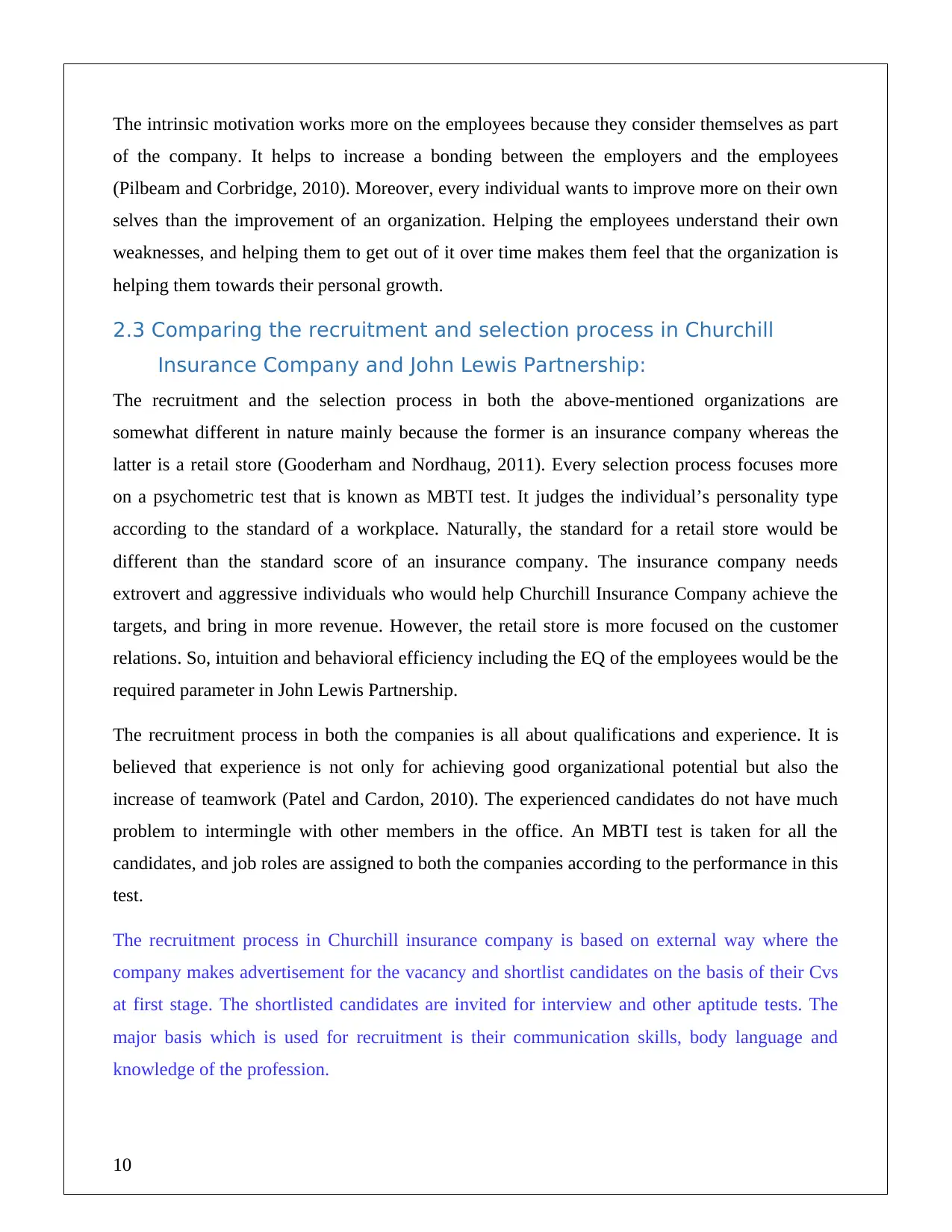
The intrinsic motivation works more on the employees because they consider themselves as part
of the company. It helps to increase a bonding between the employers and the employees
(Pilbeam and Corbridge, 2010). Moreover, every individual wants to improve more on their own
selves than the improvement of an organization. Helping the employees understand their own
weaknesses, and helping them to get out of it over time makes them feel that the organization is
helping them towards their personal growth.
2.3 Comparing the recruitment and selection process in Churchill
Insurance Company and John Lewis Partnership:
The recruitment and the selection process in both the above-mentioned organizations are
somewhat different in nature mainly because the former is an insurance company whereas the
latter is a retail store (Gooderham and Nordhaug, 2011). Every selection process focuses more
on a psychometric test that is known as MBTI test. It judges the individual’s personality type
according to the standard of a workplace. Naturally, the standard for a retail store would be
different than the standard score of an insurance company. The insurance company needs
extrovert and aggressive individuals who would help Churchill Insurance Company achieve the
targets, and bring in more revenue. However, the retail store is more focused on the customer
relations. So, intuition and behavioral efficiency including the EQ of the employees would be the
required parameter in John Lewis Partnership.
The recruitment process in both the companies is all about qualifications and experience. It is
believed that experience is not only for achieving good organizational potential but also the
increase of teamwork (Patel and Cardon, 2010). The experienced candidates do not have much
problem to intermingle with other members in the office. An MBTI test is taken for all the
candidates, and job roles are assigned to both the companies according to the performance in this
test.
The recruitment process in Churchill insurance company is based on external way where the
company makes advertisement for the vacancy and shortlist candidates on the basis of their Cvs
at first stage. The shortlisted candidates are invited for interview and other aptitude tests. The
major basis which is used for recruitment is their communication skills, body language and
knowledge of the profession.
10
of the company. It helps to increase a bonding between the employers and the employees
(Pilbeam and Corbridge, 2010). Moreover, every individual wants to improve more on their own
selves than the improvement of an organization. Helping the employees understand their own
weaknesses, and helping them to get out of it over time makes them feel that the organization is
helping them towards their personal growth.
2.3 Comparing the recruitment and selection process in Churchill
Insurance Company and John Lewis Partnership:
The recruitment and the selection process in both the above-mentioned organizations are
somewhat different in nature mainly because the former is an insurance company whereas the
latter is a retail store (Gooderham and Nordhaug, 2011). Every selection process focuses more
on a psychometric test that is known as MBTI test. It judges the individual’s personality type
according to the standard of a workplace. Naturally, the standard for a retail store would be
different than the standard score of an insurance company. The insurance company needs
extrovert and aggressive individuals who would help Churchill Insurance Company achieve the
targets, and bring in more revenue. However, the retail store is more focused on the customer
relations. So, intuition and behavioral efficiency including the EQ of the employees would be the
required parameter in John Lewis Partnership.
The recruitment process in both the companies is all about qualifications and experience. It is
believed that experience is not only for achieving good organizational potential but also the
increase of teamwork (Patel and Cardon, 2010). The experienced candidates do not have much
problem to intermingle with other members in the office. An MBTI test is taken for all the
candidates, and job roles are assigned to both the companies according to the performance in this
test.
The recruitment process in Churchill insurance company is based on external way where the
company makes advertisement for the vacancy and shortlist candidates on the basis of their Cvs
at first stage. The shortlisted candidates are invited for interview and other aptitude tests. The
major basis which is used for recruitment is their communication skills, body language and
knowledge of the profession.
10
Paraphrase This Document
Need a fresh take? Get an instant paraphrase of this document with our AI Paraphraser
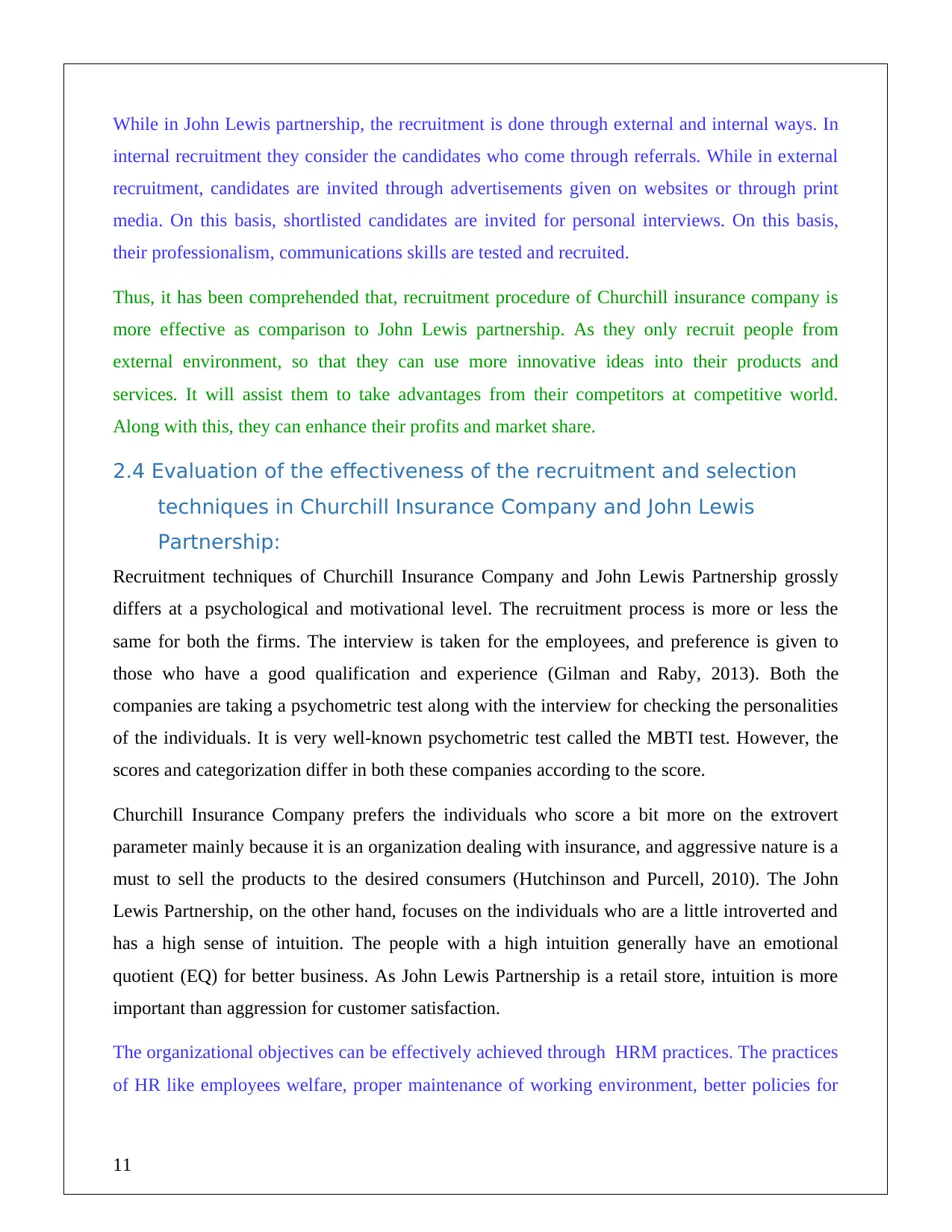
While in John Lewis partnership, the recruitment is done through external and internal ways. In
internal recruitment they consider the candidates who come through referrals. While in external
recruitment, candidates are invited through advertisements given on websites or through print
media. On this basis, shortlisted candidates are invited for personal interviews. On this basis,
their professionalism, communications skills are tested and recruited.
Thus, it has been comprehended that, recruitment procedure of Churchill insurance company is
more effective as comparison to John Lewis partnership. As they only recruit people from
external environment, so that they can use more innovative ideas into their products and
services. It will assist them to take advantages from their competitors at competitive world.
Along with this, they can enhance their profits and market share.
2.4 Evaluation of the effectiveness of the recruitment and selection
techniques in Churchill Insurance Company and John Lewis
Partnership:
Recruitment techniques of Churchill Insurance Company and John Lewis Partnership grossly
differs at a psychological and motivational level. The recruitment process is more or less the
same for both the firms. The interview is taken for the employees, and preference is given to
those who have a good qualification and experience (Gilman and Raby, 2013). Both the
companies are taking a psychometric test along with the interview for checking the personalities
of the individuals. It is very well-known psychometric test called the MBTI test. However, the
scores and categorization differ in both these companies according to the score.
Churchill Insurance Company prefers the individuals who score a bit more on the extrovert
parameter mainly because it is an organization dealing with insurance, and aggressive nature is a
must to sell the products to the desired consumers (Hutchinson and Purcell, 2010). The John
Lewis Partnership, on the other hand, focuses on the individuals who are a little introverted and
has a high sense of intuition. The people with a high intuition generally have an emotional
quotient (EQ) for better business. As John Lewis Partnership is a retail store, intuition is more
important than aggression for customer satisfaction.
The organizational objectives can be effectively achieved through HRM practices. The practices
of HR like employees welfare, proper maintenance of working environment, better policies for
11
internal recruitment they consider the candidates who come through referrals. While in external
recruitment, candidates are invited through advertisements given on websites or through print
media. On this basis, shortlisted candidates are invited for personal interviews. On this basis,
their professionalism, communications skills are tested and recruited.
Thus, it has been comprehended that, recruitment procedure of Churchill insurance company is
more effective as comparison to John Lewis partnership. As they only recruit people from
external environment, so that they can use more innovative ideas into their products and
services. It will assist them to take advantages from their competitors at competitive world.
Along with this, they can enhance their profits and market share.
2.4 Evaluation of the effectiveness of the recruitment and selection
techniques in Churchill Insurance Company and John Lewis
Partnership:
Recruitment techniques of Churchill Insurance Company and John Lewis Partnership grossly
differs at a psychological and motivational level. The recruitment process is more or less the
same for both the firms. The interview is taken for the employees, and preference is given to
those who have a good qualification and experience (Gilman and Raby, 2013). Both the
companies are taking a psychometric test along with the interview for checking the personalities
of the individuals. It is very well-known psychometric test called the MBTI test. However, the
scores and categorization differ in both these companies according to the score.
Churchill Insurance Company prefers the individuals who score a bit more on the extrovert
parameter mainly because it is an organization dealing with insurance, and aggressive nature is a
must to sell the products to the desired consumers (Hutchinson and Purcell, 2010). The John
Lewis Partnership, on the other hand, focuses on the individuals who are a little introverted and
has a high sense of intuition. The people with a high intuition generally have an emotional
quotient (EQ) for better business. As John Lewis Partnership is a retail store, intuition is more
important than aggression for customer satisfaction.
The organizational objectives can be effectively achieved through HRM practices. The practices
of HR like employees welfare, proper maintenance of working environment, better policies for
11
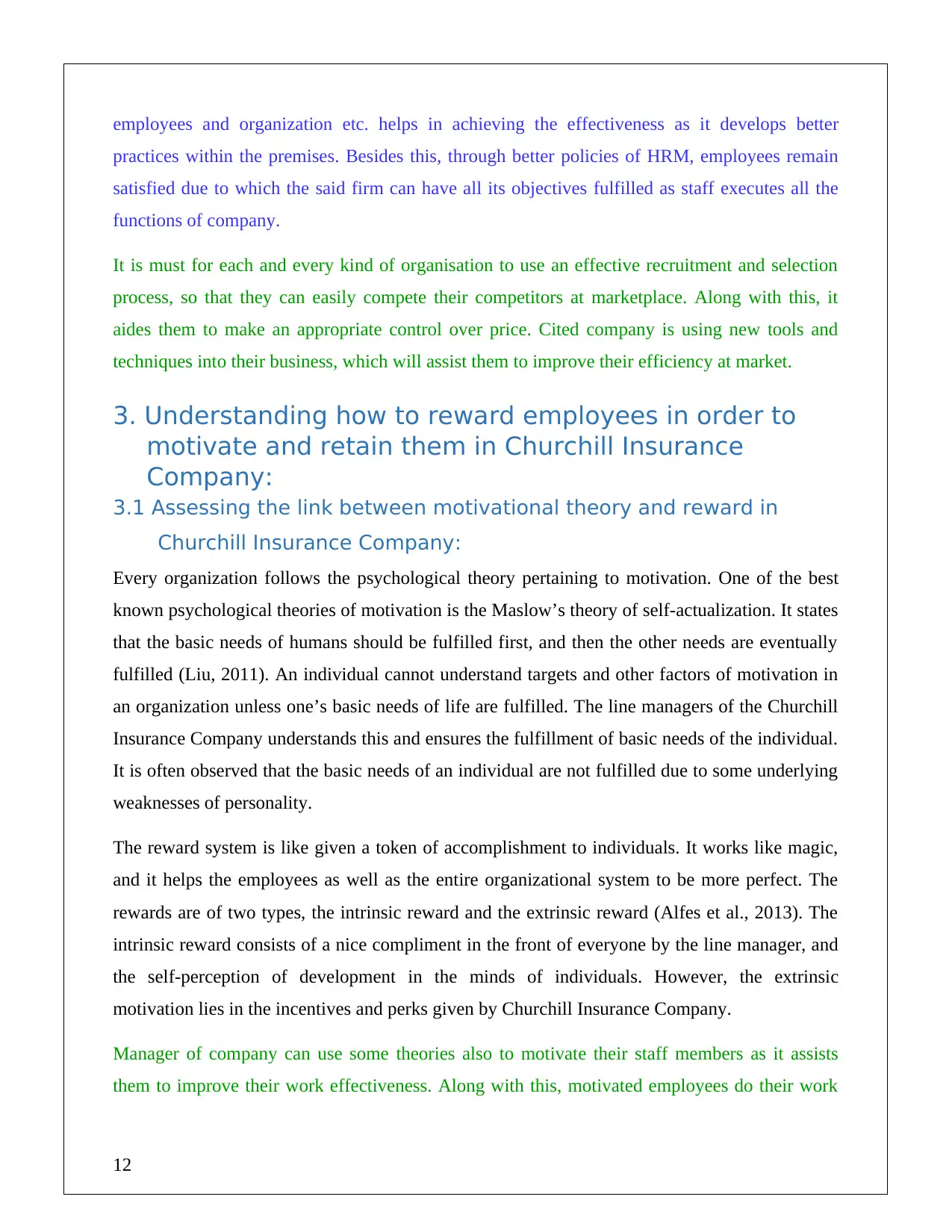
employees and organization etc. helps in achieving the effectiveness as it develops better
practices within the premises. Besides this, through better policies of HRM, employees remain
satisfied due to which the said firm can have all its objectives fulfilled as staff executes all the
functions of company.
It is must for each and every kind of organisation to use an effective recruitment and selection
process, so that they can easily compete their competitors at marketplace. Along with this, it
aides them to make an appropriate control over price. Cited company is using new tools and
techniques into their business, which will assist them to improve their efficiency at market.
3. Understanding how to reward employees in order to
motivate and retain them in Churchill Insurance
Company:
3.1 Assessing the link between motivational theory and reward in
Churchill Insurance Company:
Every organization follows the psychological theory pertaining to motivation. One of the best
known psychological theories of motivation is the Maslow’s theory of self-actualization. It states
that the basic needs of humans should be fulfilled first, and then the other needs are eventually
fulfilled (Liu, 2011). An individual cannot understand targets and other factors of motivation in
an organization unless one’s basic needs of life are fulfilled. The line managers of the Churchill
Insurance Company understands this and ensures the fulfillment of basic needs of the individual.
It is often observed that the basic needs of an individual are not fulfilled due to some underlying
weaknesses of personality.
The reward system is like given a token of accomplishment to individuals. It works like magic,
and it helps the employees as well as the entire organizational system to be more perfect. The
rewards are of two types, the intrinsic reward and the extrinsic reward (Alfes et al., 2013). The
intrinsic reward consists of a nice compliment in the front of everyone by the line manager, and
the self-perception of development in the minds of individuals. However, the extrinsic
motivation lies in the incentives and perks given by Churchill Insurance Company.
Manager of company can use some theories also to motivate their staff members as it assists
them to improve their work effectiveness. Along with this, motivated employees do their work
12
practices within the premises. Besides this, through better policies of HRM, employees remain
satisfied due to which the said firm can have all its objectives fulfilled as staff executes all the
functions of company.
It is must for each and every kind of organisation to use an effective recruitment and selection
process, so that they can easily compete their competitors at marketplace. Along with this, it
aides them to make an appropriate control over price. Cited company is using new tools and
techniques into their business, which will assist them to improve their efficiency at market.
3. Understanding how to reward employees in order to
motivate and retain them in Churchill Insurance
Company:
3.1 Assessing the link between motivational theory and reward in
Churchill Insurance Company:
Every organization follows the psychological theory pertaining to motivation. One of the best
known psychological theories of motivation is the Maslow’s theory of self-actualization. It states
that the basic needs of humans should be fulfilled first, and then the other needs are eventually
fulfilled (Liu, 2011). An individual cannot understand targets and other factors of motivation in
an organization unless one’s basic needs of life are fulfilled. The line managers of the Churchill
Insurance Company understands this and ensures the fulfillment of basic needs of the individual.
It is often observed that the basic needs of an individual are not fulfilled due to some underlying
weaknesses of personality.
The reward system is like given a token of accomplishment to individuals. It works like magic,
and it helps the employees as well as the entire organizational system to be more perfect. The
rewards are of two types, the intrinsic reward and the extrinsic reward (Alfes et al., 2013). The
intrinsic reward consists of a nice compliment in the front of everyone by the line manager, and
the self-perception of development in the minds of individuals. However, the extrinsic
motivation lies in the incentives and perks given by Churchill Insurance Company.
Manager of company can use some theories also to motivate their staff members as it assists
them to improve their work effectiveness. Along with this, motivated employees do their work
12
⊘ This is a preview!⊘
Do you want full access?
Subscribe today to unlock all pages.

Trusted by 1+ million students worldwide
1 out of 19
Related Documents
Your All-in-One AI-Powered Toolkit for Academic Success.
+13062052269
info@desklib.com
Available 24*7 on WhatsApp / Email
![[object Object]](/_next/static/media/star-bottom.7253800d.svg)
Unlock your academic potential
Copyright © 2020–2025 A2Z Services. All Rights Reserved. Developed and managed by ZUCOL.





